Darrington Mayor Dan Rankin looks to innovation—and cultivating a sense of place—to create opportunities for locals to invest and engage in their evolving rural community.
By: As told to Jen Krazit
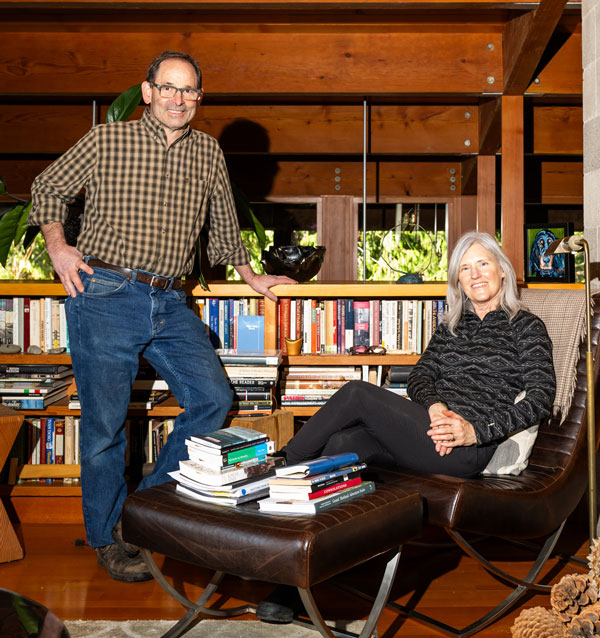
Darrington Mayor Dan Rankin at home with his wife, Kelli. Credit: Chona Kasinger
You were born and raised in Darrington but left as a young adult. What brought you back?
I went away for college and traveled a lot up and down the coast for work. My wife Kelli and I lived in suburbia for a while. We came back because we wanted to raise our kids close to family in a community that we could be a part of.
What do you do for a living?
I operate a one-man custom sawmill but only have time to do small projects. I still work with the U.S. Forest Service, national parks, and state parks—cutting lumber for the restoration of historic facilities, boardwalks, or specialty projects, as well as doing some private work for woodworkers. But since the Oso/SR530 landslide in 2014, I’ve pretty much been a full-time mayor.
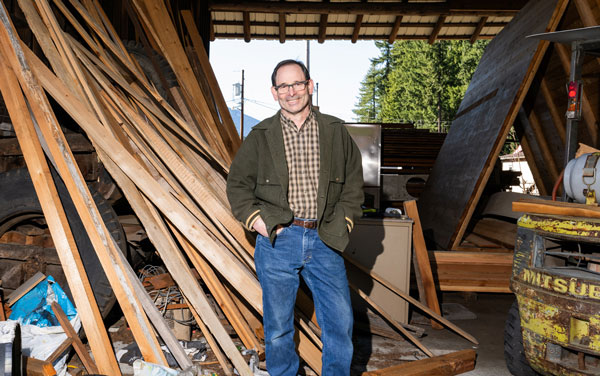
Rankin at his custom sawmill. Credit: Chona Kasinger
Do you have primary takeaways from the past decade?
Rural communities are tough. The biggest challenge we face is we’re a remote community in a fairly populous county and are often left out due to our unique location and small population. One of the things that I changed during my tenure is engaging with our county, state, and federal officials. We’re surrounded by federal forest lands, so in order for us to move forward in this location, I have to work with all three of those agencies. And that’s developing relationships with each one of those folks.
Another challenge we face is that close to 60% of our workforce leaves our valley every day, commuting to Arlington, Mount Vernon, Everett, or even Seattle. That means they do their shopping out of the valley, so there is a financial drain. And if you have two parents who are both commuting and they have young kids, they’re using childcare and school districts closer to where they work. These kids develop friends and cohorts elsewhere, so a lot of them don’t come back to Darrington when they’re older, which is a big hit on our school districts.
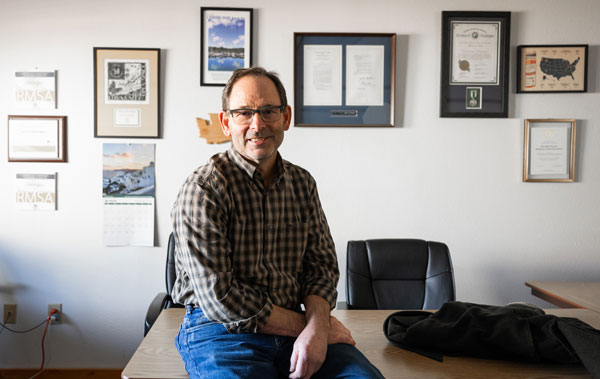
Rankin in his office at city hall. Credit: Chona Kasinger
Unlike many rural Washington communities, timber is still a viable industry and drives the local economy. What has Darrington done differently?
There are a lot of interesting and dynamic things going on with mass timber, glulam, and modular manufacturing. We’re trying to build on that innovation and collaboration mindset to bring Washington state and the U.S. up to the same level as other parts of the world, which have embraced wood for decades. We’re using building materials that are totally renewable and can sequester carbon, but also being mindful of doing what’s right for our environment and stewarding our resources responsibly. We’re grateful to have Hampton Lumber here, diversifying our industry and embracing innovation. And with these types of innovations in the wood industry, we can draw back some of these folks who are commuting, so they can work, live, and play right here. That could bring much more wealth into the community and actually build wealth here.
With these types of innovations in the wood industry, we can draw back some of these folks who are commuting, so they can work, live, and play right here. That could bring much more wealth into the community and actually build wealth here.
The Oso landslide was a major disaster in an area with limited municipal resources. What enabled you to navigate the initial response and recovery efforts?
Teamwork, trust, and being a rural forest community with a skilled workforce. I had a little bit of wildland fire experience but no formal training in emergency management. I trusted in the relationships of local folks who did have that experience, like our fire chief and the county deputy sheriff, who I coached baseball with. We had mutual respect and trust in each other, and that mindset carried on throughout the whole mission. We did things you’re not supposed to do. We trusted volunteers to participate at levels they were capable of. So, we had volunteers who were cutting trees, running excavators, or made sandwiches, delivered those sandwiches, and delivered supplies, but we also had people on the ground in the slide who did the very difficult and sometimes horrible work that that event necessitated. In one day, volunteers deployed almost a million tons of heavy equipment, with operators, to the site.
After the landslide, Snohomish County gave the community a $4 million grant for transportation. Through ingenuity in this office, we took that $4 million and built it into almost $13 million of infrastructure improvements, like sidewalks, street preservation and reconstruction. But we also used those projects as a catalyst to build out our water system, as well as supporting foot and bicycle trails.
The last time you spoke with Citivision in 2014, several outdoor recreation and education initiatives were in the works. What opportunities have they created in Darrington?
After the slide, we were fortunate to be able to pull some projects off the shelf and not only move them an inch but move them a mile. Recreation for the community was one of those projects, getting people outdoors and engaging in new and transformative outdoor recreation. Working with the Department of Natural Resources and Evergreen Mountain Bike Alliance we were able to create the North Mountain Bicycle Park. It was built to allow for a lower-skills course, where a novice can come and learn about trail riding, making it very accessible to Darrington youth. Then, as you graduate to higher levels, you can go to the upper mountain, which is a rigorous and challenging mountain bike opportunity. The cool thing is that the whole establishment is bikeable from town.
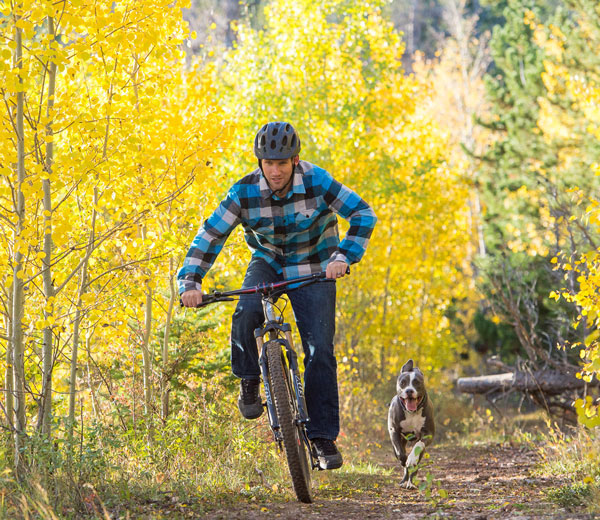
Nate Adams and his dog, Scout, on the North Mountain Bicycle Park’s Dadd Gulch Trail. Credit: Nate Adams
Any other positive outcomes?
The landslide provided the impetus to create the Glacier Peak Institute [GPI], which uses our surrounding environment and rural culture, not as a barrier, but as a superpower for youth and community development. They offer outdoor education—taking kids to work on trails and develop skills, learn about hard work, and figure out how to engage in nature responsibly. Before the slide, there were no opportunities for youth to connect and learn from the local environment. Urban environmental education programs bring urban youth up to the mountains but skip over the youth who live there. Through GPI’s programs, school-age youth can learn about fishing, foraging, forestry, growing food, working in a greenhouse, and rehabilitating a conifer seed orchard. In another GPI program, nutrient enhancement of the local fish hatchery, youth relocate spawned salmon to the highlands to study biodiversity and protein distribution throughout the environment. It puts youth at the center of the ecosystem where they are a part of it, and can discuss past historical conditions, compare current conditions and solve for problems facing our communities and ecosystems. And there’s an urban component. Last month they went down to Edmonds to go squid fishing with the Korean Community Service Center, bringing rural and urban youth together while introducing our youth to the dynamics of not only salt water and a more urban environment, but a whole different cultural aspect as well.
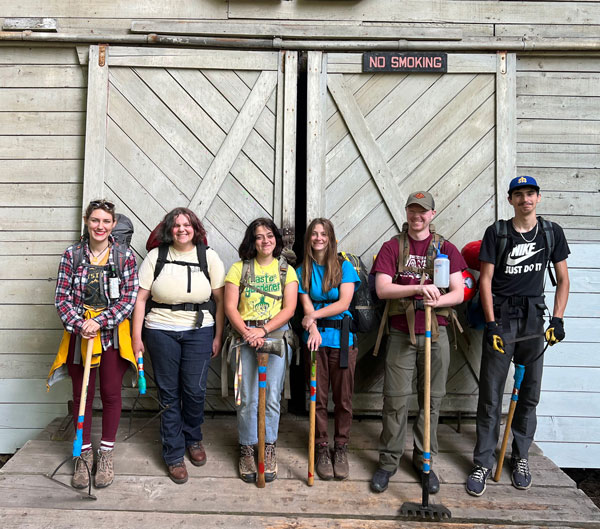
Glacier Peak Institute youth volunteers prepare to leave for a work trip that will involve several days of trail maintenance and camping. Credit: Courtesy Glacier Peak Institute
What else are you working on?
We’re looking at ways to boomerang our youth back to the community they grew up in, so they can use their knowledge, wisdom, and abilities in their hometown. We’re engaging with WSU and its extensions to expose young people to career pathways in forestry and ecology, so that they can come back. But if they don’t, wherever they land, they’ll be good citizens and community members.
The Wood Innovation Center is an initiative of economic symbiosis, using the skills of the timber industry here while looking at innovation that can bring new technologies, new skillsets, and new directions for wood products—so that architects and engineers, scientists and educators, industry and emerging industry can all be included in this effort. We’re getting ready to break ground on the infrastructure that would allow those institutions to be here in Darrington and build on our history in the spirit of place. We’ve amassed almost $10 million to get it off the ground.
We’re looking at ways to boomerang our youth back to the community they grew up in, so they can use their knowledge, wisdom, and abilities in their hometown.
What’s one thing you’ve learned that has made you a better mayor?
Engaging in and appreciating the speed of government, which is slow. Because the government moves at a snail’s pace, it allows consensus and direction to be built. By the time you’re ready to hit the “go” button, you usually know that it’s the right thing for your community. It doesn’t support knee-jerk, reactionary policies or projects. We have to think not about this month, this year, or my term; we have to think about the future of the community.
We have to think not about this month, this year, or my term; we have to think about the future of the community.
What’s the secret to Darrington’s success?
Being true to our community and our sense of space. That does not sound complex, but it is very complex. If you look at the history of this place, we’ve always been associated with the environment we’re in. Before white people settled here, Native Americans engaged in the environment, using wood in their structures and housing, in canoes for transportation—even utilizing bark for clothing and baskets. The innovative ways they used those natural resources was amazing. The timber industry also innovated in this space. Whether you like it or not, some of the most incredible logging systems were pioneered in this area. So wood is a part of this space, and the opportunities to engage with that resource to its highest and best use is part of looking forward and engaging in your community.
What advice do you have for newly electeds?
There is no “easy” button. The barking dog is a complex scenario. Go into those scenarios with eyes and ears wide open. You’ve got to go in with zero judgment and leave your own opinions at home when you walk out the door. Meet your counterparts in other towns and cities. These relationships are invaluable as we all lead our communities to our own future.